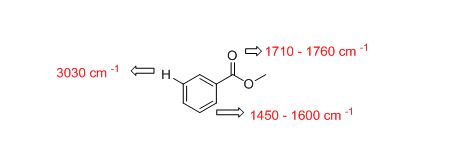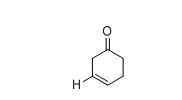
Concept explainers
At what approximate positions might the following compounds show IR absorptions?

a)
Interpretation:
The approximate absorption frequency has to be given for compound.
Concept introduction:
Spectroscopy: It is study of the interaction of matter and electromagnetic radiation, a continuum of different types of electromagnetic radiation each associated with a particular energy range makes up the electromagnetic spectrum.
IR frequency (cm-1): It is the number of wave crests that pass by a given point in one second frequency has units of hertz (Hz).
Stretch vibrations: It is a vibration occurring along the line of the bond a stretching vibration changes the bond length.
Bending vibrations: It is a vibration that does not occur along the line of the bond, bending vibration changes the bond angle.
Answer to Problem 33AP
The IR absorptions values at 1450-1600 cm-1 is for carbon double bond carbon stretching frequency, 3030 cm-1 is for aromatic carbon hydrogen stretching frequency, 1710-1760 cm-1 is for acid carbonyl frequency and 2500-3100 cm-1 is for acid hydroxyl frequency.
Explanation of Solution
Given information:
The approximate absorption frequency for the given compound,

The IR absorptions values at 1450-1600 cm-1 is for carbon double bond carbon stretching frequency, 3030 cm-1 is for aromatic carbon hydrogen stretching frequency, 1710-1760 cm-1 is for acid carbonyl frequency and 2500-3100 cm-1 is for acid hydroxyl frequency.
Therefore, the approximate absorption frequency for the given compound is shown below,

The approximate absorption frequency is given for compound.
b)
Interpretation:
The approximate absorption frequency has to be given for compound.
Concept introduction:
Spectroscopy: It is study of the interaction of matter and electromagnetic radiation, a continuum of different types of electromagnetic radiation each associated with a particular energy range makes up the electromagnetic spectrum.
IR frequency (cm-1): It is the number of wave crests that pass by a given point in one second frequency has units of hertz (Hz).
Stretch vibrations: It is a vibration occurring along the line of the bond a stretching vibration changes the bond length.
Bending vibrations: It is a vibration that does not occur along the line of the bond, bending vibration changes the bond angle.
Answer to Problem 33AP
The IR absorptions values at 1450-1600 cm-1 is for carbon double bond carbon stretching frequency, 3030 cm-1 is for aromatic carbon hydrogen stretching frequency, 1710-1760 cm-1 is for acid carbonyl frequency and 2500-3100 cm-1 is for acid hydroxyl frequency.
Explanation of Solution
Given information:
The approximate absorption frequency for the given compound,

The IR absorptions values at 1450-1600 cm-1 is for carbon double bond carbon stretching frequency, 3030 cm-1 is for aromatic carbon hydrogen stretching frequency, 1710-1760 cm-1 is for acid carbonyl frequency and 2500-3100 cm-1 is for acid hydroxyl frequency.
Therefore, the approximate absorption frequency for the given compound is shown below,

The difference between given pairs of isomers is explained by using infrared spectroscopy.
c)
Interpretation:
The difference between given pairs of isomer has to be explained by using infrared spectroscopy.
Concept introduction:
Spectroscopy: It is study of the interaction of matter and electromagnetic radiation, a continuum of different types of electromagnetic radiation each associated with a particular energy range makes up the electromagnetic spectrum.
IR frequency (cm-1): It is the number of wave crests that pass by a given point in one second frequency has units of hertz (Hz).
Stretch vibrations: It is a vibration occurring along the line of the bond a stretching vibration changes the bond length.
Bending vibrations: It is a vibration that does not occur along the line of the bond, bending vibration changes the bond angle.
Answer to Problem 33AP
The IR absorptions values at 1450-1600 cm-1 is for carbon double bond carbon stretching frequency, 3030 cm-1 is for aromatic carbon hydrogen stretching frequency, 2210-2260 cm-1 is for acid carbonyl frequency and 3400-3650 cm-1 is for acid hydroxyl frequency.
Explanation of Solution
Given information:
The approximate absorption frequency for the given compound,

The IR absorptions values at 1450-1600 cm-1 is for carbon double bond carbon stretching frequency, 3030 cm-1 is for aromatic carbon hydrogen stretching frequency, 2210-2260 cm-1 is for acid carbonyl frequency and 3400-3650 cm-1 is for acid hydroxyl frequency.
Therefore, the approximate absorption frequency for the given compound is shown below,

The difference between given pairs of isomers is explained by using infrared spectroscopy.
d)
Interpretation:
The difference between given pairs of isomer has to be explained by using infrared spectroscopy.
Concept introduction:
Spectroscopy: It is study of the interaction of matter and electromagnetic radiation, a continuum of different types of electromagnetic radiation each associated with a particular energy range makes up the electromagnetic spectrum.
IR frequency (cm-1): It is the number of wave crests that pass by a given point in one second frequency has units of hertz (Hz).
Stretch vibrations: It is a vibration occurring along the line of the bond a stretching vibration changes the bond length.
Bending vibrations: It is a vibration that does not occur along the line of the bond, bending vibration changes the bond angle.
Answer to Problem 33AP
The IR absorptions values at 1640-1680 cm-1 is for carbon double bond carbon stretching frequency, 3020-3100 cm-1 is for vinylic carbon hydrogen stretching frequency and 1715 cm-1 is for acid hydroxyl frequency.
Explanation of Solution
Given information:
The approximate absorption frequency for the given compound,

The IR absorptions values at 1640-1680 cm-1 is for carbon double bond carbon stretching frequency, 3020-3100 cm-1 is for vinylic carbon hydrogen stretching frequency and 1715 cm-1 is for acid hydroxyl frequency.
Therefore, the approximate absorption frequency for the given compound is shown below,

The difference between given pairs of isomers is explained by using infrared spectroscopy.
e)
Interpretation:
The difference between given pairs of isomer has to be explained by using infrared spectroscopy.
Concept introduction:
Spectroscopy: It is study of the interaction of matter and electromagnetic radiation, a continuum of different types of electromagnetic radiation each associated with a particular energy range makes up the electromagnetic spectrum.
IR frequency (cm-1): It is the number of wave crests that pass by a given point in one second frequency has units of hertz (Hz).
Stretch vibrations: It is a vibration occurring along the line of the bond a stretching vibration changes the bond length.
Bending vibrations: It is a vibration that does not occur along the line of the bond, bending vibration changes the bond angle.
Answer to Problem 33AP
The IR absorptions values at 1715 cm-1 is for carbonyl (ketone) stretching frequency and 1735 cm-1 is for carbonyl ester frequency.
Explanation of Solution
Given information:
The approximate absorption frequency for the given compound,

The IR absorptions values at 1715 cm-1 is for carbonyl (ketone) stretching frequency and 1735 cm-1 is for carbonyl ester frequency.
Therefore, the approximate absorption frequency for the given compound is shown below,

The difference between given pairs of isomers is explained by using infrared spectroscopy.
Want to see more full solutions like this?
Chapter 12 Solutions
Bundle: Organic Chemistry, Loose-leaf Version, 9th + LMS Integrated for OWLv2, 4 terms (24 months) Printed Access Card
- Where might the following compounds have IR absorptions?arrow_forwardFor each compound with formula C4H8O2, provide a brief reason why it could or could not match the IR spectrum.arrow_forwardIR Spectrum Directions: Identify the major IR absorptions. Once you have deduced the structure of the unknown, write the name of the unknown compound. Observe and Explain why it happened. P.S MAKE SURE THAT IF YOU PUT AN IMAGE MAKE SURE IT CAN BE VIEWED.arrow_forward
- Identify the major IR absorptions and write the name of the unknown compound and its structure.arrow_forwardIdentify the peaks in the ir spectraarrow_forwardwhat does it mean if a compound has a peak that has medium stretch at 1658cm-1 in an IR spectra? Does it mean there is a possiblity that the compound could be a ketone?arrow_forward
- Which of these compounds matches to the IR spectrum?arrow_forwardIdentify the important absorption peaks in the following IR spectra and describe the appearance of the important absorption peaks in the IR Spectra. No cursive writing please. Thank youarrow_forwardThese are the 1H spectrums for compounds Y and Z (molecular formula on the image). They both show a stretch around 1710cm-1 on the IR spectrum. What are the structures for both Y and Z?arrow_forward
- For each of the following pairs of compounds, identify one IR absorption band that could be used to distinguish between them:arrow_forwardName the major IR absorptions and write the name of the unknown compound and its structure.arrow_forwardIR Spectrum Directions: Identify the major IR absorptions. Once you have deduced the structure of the unknown, write the name of the unknown compound. Observe and Explain why it happened.arrow_forward
